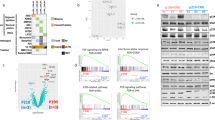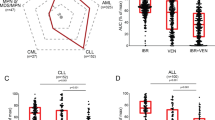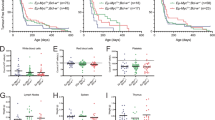Abstract
Patients with chronic myeloid leukemia who become resistant to the Abl kinase inhibitor imatinib can be treated with dasatinib. This sequential treatment can lead to BCR-ABL mutations conferring broad resistance to kinase inhibitors. To model the evolution of resistance, we exposed the mouse DA1-3b BCR-ABL+ leukemic cell line to imatinib for several months, and obtained resistant cells carrying the E255K mutation. We then exposed these cells to dasatinib, and obtained dasatinib-resistant cells with composite E255K+T315I mutations. Subcloning isolated a minor clone also carrying V299L. In co-culture, mutated cells were able to spread resistance to non-mutated cells through overexpression of interleukin 3, activation of MEK/ERK and JAK2/STAT5 pathways, and downregulation of Bim. Even the presence of less than 10% of mutated cells was sufficient to protect non-mutated cells. Blocking JAK2 and MEK1/2 inhibited the protective effect of co-culture. Mutated cells were also sensitive to JAK2 inhibition, but blocking MEK1/2 alone, or in association with kinase inhibitors, had little effect. These data indicate that sequential Abl kinase inhibitor therapy can generate sub-populations of mutated cells, which may coexist with non-mutated cells and protect them through a paracrine mechanism. Targeting JAK2 could eliminate both populations.
This is a preview of subscription content, access via your institution
Access options
Subscribe to this journal
Receive 12 print issues and online access
$259.00 per year
only $21.58 per issue
Buy this article
- Purchase on Springer Link
- Instant access to full article PDF
Prices may be subject to local taxes which are calculated during checkout






Similar content being viewed by others
References
Cortes J, Jabbour E, Kantarjian H, Yin CC, Shan J, O'Brien S et al. Dynamics of BCR-ABL kinase domain mutations in chronic myeloid leukemia after sequential treatment with multiple tyrosine kinase inhibitors. Blood 2007; 110: 4005–4011.
Shah NP, Skaggs BJ, Branford S, Hughes TP, Nicoll JM, Paquette RL et al. Sequential ABL kinase inhibitor therapy selects for compound drug-resistant BCR-ABL mutations with altered oncogenic potency. J Clin Invest 2007; 117: 2562–2569.
Talpaz M, Shah NP, Kantarjian H, Donato N, Nicoll J, Paquette R et al. Dasatinib in imatinib-resistant Philadelphia chromosome-positive leukemias. N Engl J Med 2006; 354: 2531–2541.
Burgess MR, Skaggs BJ, Shah NP, Lee FY, Sawyers CL . Comparative analysis of two clinically active BCR-ABL kinase inhibitors reveals the role of conformation-specific binding in resistance. Proc Natl Acad Sci USA 2005; 102: 3395–3400.
Shah NP, Nicoll JM, Nagar B, Gorre ME, Paquette RL, Kuriyan J et al. Multiple BCR-ABL kinase domain mutations confer polyclonal resistance to the tyrosine kinase inhibitor imatinib (STI571) in chronic phase and blast crisis chronic myeloid leukemia. Cancer Cell 2002; 2: 117–125.
Saudemont A, Hamrouni A, Marchetti P, Liu J, Jouy N, Hetuin D et al. Dormant tumor cells develop cross-resistance to apoptosis induced by CTLs or imatinib mesylate via methylation of suppressor of cytokine signaling 1. Cancer Res 2007; 67: 4491–4498.
Saudemont A, Quesnel B . In a model of tumor dormancy, long-term persistent leukemic cells have increased B7-H1 and B7.1 expression and resist CTL-mediated lysis. Blood 2004; 104: 2124–2133.
Vereecque R, Buffenoir G, Gonzalez R, Preudhomme C, Fenaux P, Quesnel B . A new murine aggressive leukemic model. Leuk Res 1999; 23: 415–416.
Nguyen TK, Rahmani M, Harada H, Dent P, Grant S . MEK1/2 inhibitors sensitize Bcr/Abl+ human leukemia cells to the dual Abl/Src inhibitor BMS-354/825. Blood 2007; 109: 4006–4015.
de Groot RP, Raaijmakers JA, Lammers JW, Jove R, Koenderman L . STAT5 activation by BCR-Abl contributes to transformation of K562 leukemia cells. Blood 1999; 94: 1108–1112.
Klejman A, Schreiner SJ, Nieborowska-Skorska M, Slupianek A, Wilson M, Smithgall TE et al. The Src family kinase Hck couples BCR/ABL to STAT5 activation in myeloid leukemia cells. EMBO J 2002; 21: 5766–5774.
Nieborowska-Skorska M, Wasik MA, Slupianek A, Salomoni P, Kitamura T, Calabretta B et al. Signal transducer and activator of transcription (STAT)5 activation by BCR/ABL is dependent on intact Src homology (SH)3 and SH2 domains of BCR/ABL and is required for leukemogenesis. J Exp Med 1999; 189: 1229–1242.
Kuroda J, Puthalakath H, Cragg MS, Kelly PN, Bouillet P, Huang DC et al. Bim and Bad mediate imatinib-induced killing of Bcr/Abl+ leukemic cells, and resistance due to their loss is overcome by a BH3 mimetic. Proc Natl Acad Sci USA 2006; 103: 14907–14912.
Samanta AK, Lin H, Sun T, Kantarjian H, Arlinghaus RB . Janus kinase 2: a critical target in chronic myelogenous leukemia. Cancer Res 2006; 66: 6468–6472.
Yu C, Krystal G, Varticovksi L, McKinstry R, Rahmani M, Dent P et al. Pharmacologic mitogen-activated protein/extracellular signal-regulated kinase kinase/mitogen-activated protein kinase inhibitors interact synergistically with STI571 to induce apoptosis in Bcr/Abl-expressing human leukemia cells. Cancer Res 2002; 62: 188–199.
von Bubnoff N, Manley PW, Mestan J, Sanger J, Peschel C, Duyster J . Bcr-Abl resistance screening predicts a limited spectrum of point mutations to be associated with clinical resistance to the Abl kinase inhibitor nilotinib (AMN107). Blood 2006; 108: 1328–1333.
von Bubnoff N, Veach DR, van der Kuip H, Aulitzky WE, Sanger J, Seipel P et al. A cell-based screen for resistance of Bcr-Abl-positive leukemia identifies the mutation pattern for PD166326, an alternative Abl kinase inhibitor. Blood 2005; 105: 1652–1659.
Bradeen HA, Eide CA, O'Hare T, Johnson KJ, Willis SG, Lee FY et al. Comparison of imatinib mesylate, dasatinib (BMS-354825), and nilotinib (AMN107) in an N-ethyl-N-nitrosourea (ENU)-based mutagenesis screen: high efficacy of drug combinations. Blood 2006; 108: 2332–2338.
Griswold IJ, MacPartlin M, Bumm T, Goss VL, O'Hare T, Lee KA et al. Kinase domain mutants of Bcr-Abl exhibit altered transformation potency, kinase activity, and substrate utilization, irrespective of sensitivity to imatinib. Mol Cell Biol 2006; 26: 6082–6093.
Miething C, Feihl S, Mugler C, Grundler R, von Bubnoff N, Lordick F et al. The Bcr-Abl mutations T315I and Y253H do not confer a growth advantage in the absence of imatinib. Leukemia 2006; 20: 650–657.
Yamamoto M, Kurosu T, Kakihana K, Mizuchi D, Miura O . The two major imatinib resistance mutations E255K and T315I enhance the activity of BCR/ABL fusion kinase. Biochem Biophys Res Commun 2004; 319: 1272–1275.
Hariharan IK, Adams JM, Cory S . bcr-abl oncogene renders myeloid cell line factor independent: potential autocrine mechanism in chronic myeloid leukemia. Oncogene Res 1988; 3: 387–399.
Jiang X, Lopez A, Holyoake T, Eaves A, Eaves C . Autocrine production and action of IL-3 and granulocyte colony-stimulating factor in chronic myeloid leukemia. Proc Natl Acad Sci USA 1999; 96: 12804–12809.
Sirard C, Laneuville P, Dick JE . Expression of bcr-abl abrogates factor-dependent growth of human hematopoietic M07E cells by an autocrine mechanism. Blood 1994; 83: 1575–1585.
Zhang X, Ren R . Bcr-Abl efficiently induces a myeloproliferative disease and production of excess interleukin-3 and granulocyte-macrophage colony-stimulating factor in mice: a novel model for chronic myelogenous leukemia. Blood 1998; 92: 3829–3840.
Wang Y, Cai D, Brendel C, Barett C, Erben P, Manley PW et al. Adaptive secretion of granulocyte-macrophage colony-stimulating factor (GM-CSF) mediates imatinib and nilotinib resistance in BCR/ABL+ progenitors via JAK-2/STAT-5 pathway activation. Blood 2007; 109: 2147–2155.
Dorsey JF, Cunnick JM, Lanehart R, Huang M, Kraker AJ, Bhalla KN et al. Interleukin-3 protects Bcr-Abl-transformed hematopoietic progenitor cells from apoptosis induced by Bcr-Abl tyrosine kinase inhibitors. Leukemia 2002; 16: 1589–1595.
Harada H, Quearry B, Ruiz-Vela A, Korsmeyer SJ . Survival factor-induced extracellular signal-regulated kinase phosphorylates BIM, inhibiting its association with BAX and proapoptotic activity. Proc Natl Acad Sci USA 2004; 101: 15313–15317.
Matsui H, Shinjyo T, Inaba T . Structure of the human Bim gene and its transcriptional regulation in Baf-3, interleukin-3-dependent hematopoietic cells. Mol Biol Rep 2005; 32: 79–85.
Shinjyo T, Kuribara R, Inukai T, Hosoi H, Kinoshita T, Miyajima A et al. Downregulation of Bim, a proapoptotic relative of Bcl-2, is a pivotal step in cytokine-initiated survival signaling in murine hematopoietic progenitors. Mol Cell Biol 2001; 21: 854–864.
Ferrao PT, Frost MJ, Siah SP, Ashman LK . Overexpression of P-glycoprotein in K562 cells does not confer resistance to the growth inhibitory effects of imatinib (STI571) in vitro. Blood 2003; 102: 4499–4503.
Kuribara R, Honda H, Matsui H, Shinjyo T, Inukai T, Sugita K et al. Roles of Bim in apoptosis of normal and Bcr-Abl-expressing hematopoietic progenitors. Mol Cell Biol 2004; 24: 6172–6183.
Essafi A, Fernandez de Mattos S, Hassen YA, Soeiro I, Mufti GJ, Thomas NS et al. Direct transcriptional regulation of Bim by FoxO3a mediates STI571-induced apoptosis in Bcr-Abl-expressing cells. Oncogene 2005; 24: 2317–2329.
Nam S, Williams A, Vultur A, List A, Bhalla K, Smith D et al. Dasatinib (BMS-354825) inhibits Stat5 signaling associated with apoptosis in chronic myelogenous leukemia cells. Mol Cancer Ther 2007; 6: 1400–1405.
Acknowledgements
This study was supported by the Cancéropole Nord-Ouest, the Ligue Nationale Contre le Cancer (Equipe labellisée) and the Fondation de France. JL was supported by a grant from Fondation pour la Recherche Médicale and Institut de Recherche sur le Cancer de Lille.
Author information
Authors and Affiliations
Corresponding author
Additional information
Supplementary Information accompanies the paper on the Leukemia website (http://www.nature.com/leu)
Rights and permissions
About this article
Cite this article
Liu, J., Joha, S., Idziorek, T. et al. BCR-ABL mutants spread resistance to non-mutated cells through a paracrine mechanism. Leukemia 22, 791–799 (2008). https://doi.org/10.1038/leu.2008.3
Received:
Accepted:
Published:
Issue Date:
DOI: https://doi.org/10.1038/leu.2008.3
Keywords
This article is cited by
-
Genetics and tyrosine kinase inhibitors of chronic myeloid leukemia
The Nucleus (2019)
-
Clinical impact of low-burden BCR-ABL1 mutations detectable by amplicon deep sequencing in Philadelphia-positive acute lymphoblastic leukemia patients
Leukemia (2016)
-
Individualizing kinase-targeted cancer therapy: the paradigm of chronic myeloid leukemia
Genome Biology (2014)
-
Omacetaxine mepesuccinate prevents cytokine-dependent resistance to nilotinib in vitro: potential role of the common β-subunit c of cytokine receptors
Leukemia (2012)
-
GILZ inhibits the mTORC2/AKT pathway in BCR-ABL+ cells
Oncogene (2012)



